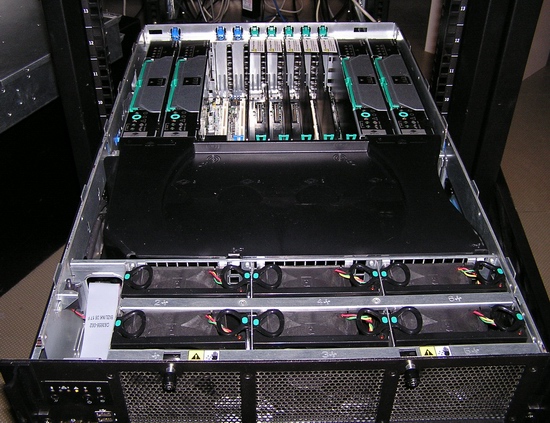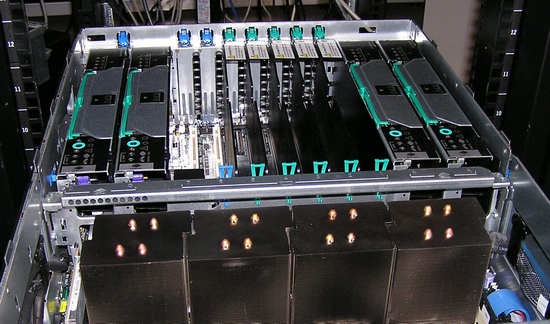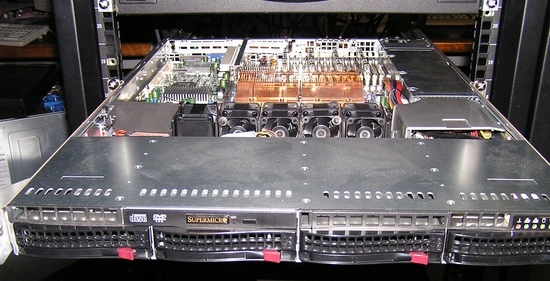Intel's newest Quad Xeon MP versus HP's DL585 Quad Opteron
by Johan De Gelas on November 10, 2006 12:00 PM EST- Posted in
- IT Computing
Intel SR6850HW4 Server
Our server was not a simple demo system, but a complete Intel Server system solution: the SR6850HW4 server. It is an enormous 6U rack/pedestal server, also available in a slimmer 4U form as the SR4850HW4. The main difference is that the 4U server has 5 (6U:10) disk bays, a bit less cooling, and smaller and slightly less powerful power supplies.

Below you can see the massive heatsinks used to cool the Xeon 71xx down.

As the new quad socket Xeon 71xx CPU fits in a 4U server, we can easily compare it with one the most popular quad Opteron servers: the HP DL585.
HP ProLiant DL585 version 2006
The HP ProLiant DL585 available in the labs was not the recently introduced DL585G2 which features DDR2, the new AMD Opteron socket F and 2.5 inch SAS drives. It is a small evolution of the HP DL585 which we reviewed back in 2004. Back then, each of the four CPU boards had 8 memory slots and supported up to 16GB (8x2GB) of DDR-266, for total of 64GB RAM. The original HP was able to use up to 48GB of DDR-333.
The latest DL585 can use 4GB DIMMs, allowing it to access no less than 128GB of DDR266. It can also use 32GB of fast DDR-400 or 64GB of DDR-333, which is very impressive. Below you can find a schematic overview of the latest DL585 technology.

The Opteron keeps a few very important advantages over the Xeon MP, not the least of which is a very elegant platform design. The quad dual core configuration generates more cache coherency traffic, as the 8 cores of the Opteron have to keep 8 L2 caches coherent while the Xeon MP has to keep track of 4 L3 caches. However four 4GB/s full duplex point to point connections make this traffic flow very smoothly while each pair of Xeon MPs have to share a 6.4GB/s half-duplex bus. The Opterons also have a fast 4.8GB/s full duplex point-to-point connection to the I/O chips.
Supermicro SS6015b-8+ server
For the price of a 4U quad socket server you can get several dual socket 1U/2U servers. There are several reasons why you would still prefer to buy the more expensive 4U server: more disk bays, more RAS features, more full height expansion slots, and of course more performance. Depending on your needs one these factors might be the decisive one. In the case of the 4U servers reviewed here, direct attached storage will not be the deciding factor, as you can get 4 or 5 disk bays in a 1 or 2U server too. If performance is the critical factor, it is clear that we must include a 1U or 2U server to see how much more performance you gain if you choose the quad socket machine.
Enter the Supermicro SS6015B-8+, which is equipped with Supermicro's X7DBR-8+ dual Xeon "Bensley platform" server board, based on the Intel 5000P chipset. While it doesn't have the RAS features of the 4U machines (for example, it doesn't have redundant PSUs), it can compete on all other points. In terms of RAM capacity for example, the Supermicro motherboard has sixteen (!) 240-pin DIMM slots that can support up to 64GB of ECC DDR2-667/533 FB-DIMMs. You can also trade in some RAM capacity for RAS: the similar SS6015B-3RV features "only" 8 DIMM slots but two 650W PSUs. The SS6015-8+ is also equipped with a SCSI or SATA backplane that offers 4 drive bays.

Due to the 1U form factor, you have to sacrifice a bit of expandability. One 133 MHz PCI-X slot can support two different riser cards, but not simultaneously. You have to choose between the PCIe riser card and the PCI-X one.
We are well aware that this particular Supermicro server is not a direct competitor. However, a similar 2U server like the 6025B will give almost the same performance numbers. The 6025B Server offers 8 drive bays, redundant power supplies and 6 expansion slots. So we are basically using the SS6015b-8+ as a "performance reference". We will try to answer the question: when do four Xeon MP or Opterons make sense, and how does it compare to the best dual Xeon available, the Xeon DP 5160?
Our server was not a simple demo system, but a complete Intel Server system solution: the SR6850HW4 server. It is an enormous 6U rack/pedestal server, also available in a slimmer 4U form as the SR4850HW4. The main difference is that the 4U server has 5 (6U:10) disk bays, a bit less cooling, and smaller and slightly less powerful power supplies.

Below you can see the massive heatsinks used to cool the Xeon 71xx down.

As the new quad socket Xeon 71xx CPU fits in a 4U server, we can easily compare it with one the most popular quad Opteron servers: the HP DL585.
HP ProLiant DL585 version 2006
The HP ProLiant DL585 available in the labs was not the recently introduced DL585G2 which features DDR2, the new AMD Opteron socket F and 2.5 inch SAS drives. It is a small evolution of the HP DL585 which we reviewed back in 2004. Back then, each of the four CPU boards had 8 memory slots and supported up to 16GB (8x2GB) of DDR-266, for total of 64GB RAM. The original HP was able to use up to 48GB of DDR-333.
The latest DL585 can use 4GB DIMMs, allowing it to access no less than 128GB of DDR266. It can also use 32GB of fast DDR-400 or 64GB of DDR-333, which is very impressive. Below you can find a schematic overview of the latest DL585 technology.

The Opteron keeps a few very important advantages over the Xeon MP, not the least of which is a very elegant platform design. The quad dual core configuration generates more cache coherency traffic, as the 8 cores of the Opteron have to keep 8 L2 caches coherent while the Xeon MP has to keep track of 4 L3 caches. However four 4GB/s full duplex point to point connections make this traffic flow very smoothly while each pair of Xeon MPs have to share a 6.4GB/s half-duplex bus. The Opterons also have a fast 4.8GB/s full duplex point-to-point connection to the I/O chips.
Supermicro SS6015b-8+ server
For the price of a 4U quad socket server you can get several dual socket 1U/2U servers. There are several reasons why you would still prefer to buy the more expensive 4U server: more disk bays, more RAS features, more full height expansion slots, and of course more performance. Depending on your needs one these factors might be the decisive one. In the case of the 4U servers reviewed here, direct attached storage will not be the deciding factor, as you can get 4 or 5 disk bays in a 1 or 2U server too. If performance is the critical factor, it is clear that we must include a 1U or 2U server to see how much more performance you gain if you choose the quad socket machine.
Enter the Supermicro SS6015B-8+, which is equipped with Supermicro's X7DBR-8+ dual Xeon "Bensley platform" server board, based on the Intel 5000P chipset. While it doesn't have the RAS features of the 4U machines (for example, it doesn't have redundant PSUs), it can compete on all other points. In terms of RAM capacity for example, the Supermicro motherboard has sixteen (!) 240-pin DIMM slots that can support up to 64GB of ECC DDR2-667/533 FB-DIMMs. You can also trade in some RAM capacity for RAS: the similar SS6015B-3RV features "only" 8 DIMM slots but two 650W PSUs. The SS6015-8+ is also equipped with a SCSI or SATA backplane that offers 4 drive bays.

Due to the 1U form factor, you have to sacrifice a bit of expandability. One 133 MHz PCI-X slot can support two different riser cards, but not simultaneously. You have to choose between the PCIe riser card and the PCI-X one.
We are well aware that this particular Supermicro server is not a direct competitor. However, a similar 2U server like the 6025B will give almost the same performance numbers. The 6025B Server offers 8 drive bays, redundant power supplies and 6 expansion slots. So we are basically using the SS6015b-8+ as a "performance reference". We will try to answer the question: when do four Xeon MP or Opterons make sense, and how does it compare to the best dual Xeon available, the Xeon DP 5160?










88 Comments
View All Comments
JohanAnandtech - Saturday, November 11, 2006 - link
Well, we did mentione it at our price comparison. From a performance point of view, the G2 is within 2% of the DL585 given a similar configuration.Getting a server in the lab is not like getting a videochip for review. The machines are much more expensive, and you need much more time to review them properly. So OEMs are less likely to send you the necessary hardware. For a videocard they send out a $500 item that can be reviewed in a few weeks, maybe even a few days. For Server like these, they have to send out a $20000 machine and be able to miss it for a month or two at the least.
Viditor - Saturday, November 11, 2006 - link
I can certainly understand and empathise with the situation...and I did enjoy the article, Johan!
The reason I mentioned it is that line in your conclusion...
I thought that (considering the circumstances) it was a bit unfair and misleading...
JohanAnandtech - Saturday, November 11, 2006 - link
I just pointed out that it is a bit weird that a newer revision of the DL585 (it was thé HP Opteron machine just a few months ago) used SCSI 160. There is no reason at all why HP could not replace this: they revised the server anyway.I should mentioned that these results were solved in the G2, but still it is a missed chance... eventhough I reported it a bit too late :-)
photoguy99 - Friday, November 10, 2006 - link
yes, bring it on!finalfan - Friday, November 10, 2006 - link
On page The Official SPEC Numbers, in second table SPEC FP 2000 Performance, the positions of (4/8) HP Opteron AM2 and (8/8) Hitachi Itanium 2 should be switched. No Itanium runs at 3.4G and no way a 4way 1.6G AM2 can sit in second place.JohanAnandtech - Friday, November 10, 2006 - link
Corrected. It is weird, the accurate numbers were in the orginal document. The generation of the table went wrong. I have double checked and now the FP numbers should all be accurateJarredWalton - Friday, November 10, 2006 - link
Probably my fault. I think when it got put into Excel that the various x/y numbers were converted to dates. I thought I fixed all of those, but probably missed one or two. Sorry.icarus4586 - Friday, November 10, 2006 - link
This report brought to you by the department of redundancy department.
bwmccann - Friday, November 10, 2006 - link
When are you guys going to start benchmarking server CPUs using applications that are widely used in organizations on a daily basis?Most companies have a very high percentage of servers running Windows. With that I would love to see some test on SQL, Oracle, Exchange, and other core components of enterprises today.
Also it would be nice to see a closer comparison of the servers. For example you tested a DL585. A DL580 (Intel Woodcrest) would have been better suited since some of the components would be the same.
JohanAnandtech - Friday, November 10, 2006 - link
http://www.anandtech.com/IT/showdoc.aspx?i=2793">http://www.anandtech.com/IT/showdoc.aspx?i=2793Most of the time Jason does the Windows benchmarking, me and my team do the Linux benchmarking.
Java, MySQL and SSL are also core components of many enterprise apps.
We are working on Oracle and got access to a realworld Oracle database a few weeks ago (for the first time), but it takes time to really understand what your benchmark is telling you and how you must configure your db. And Oracle is ...very stubborn, even patching to a slightly higher version can lead to big trouble.
The DL585 is a direct competitor (quad socket) in this space, more so than the DL580 (DUal Socket)